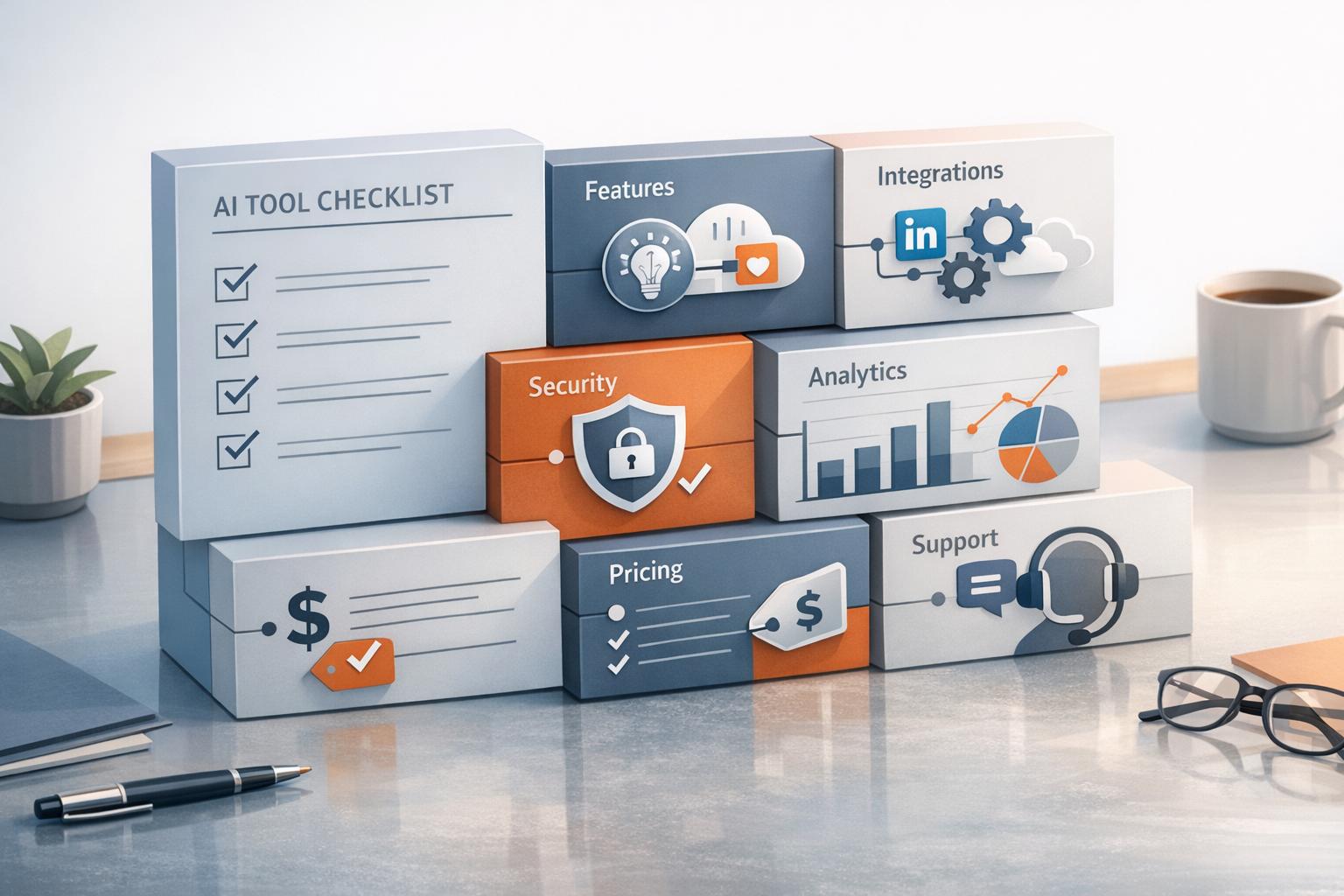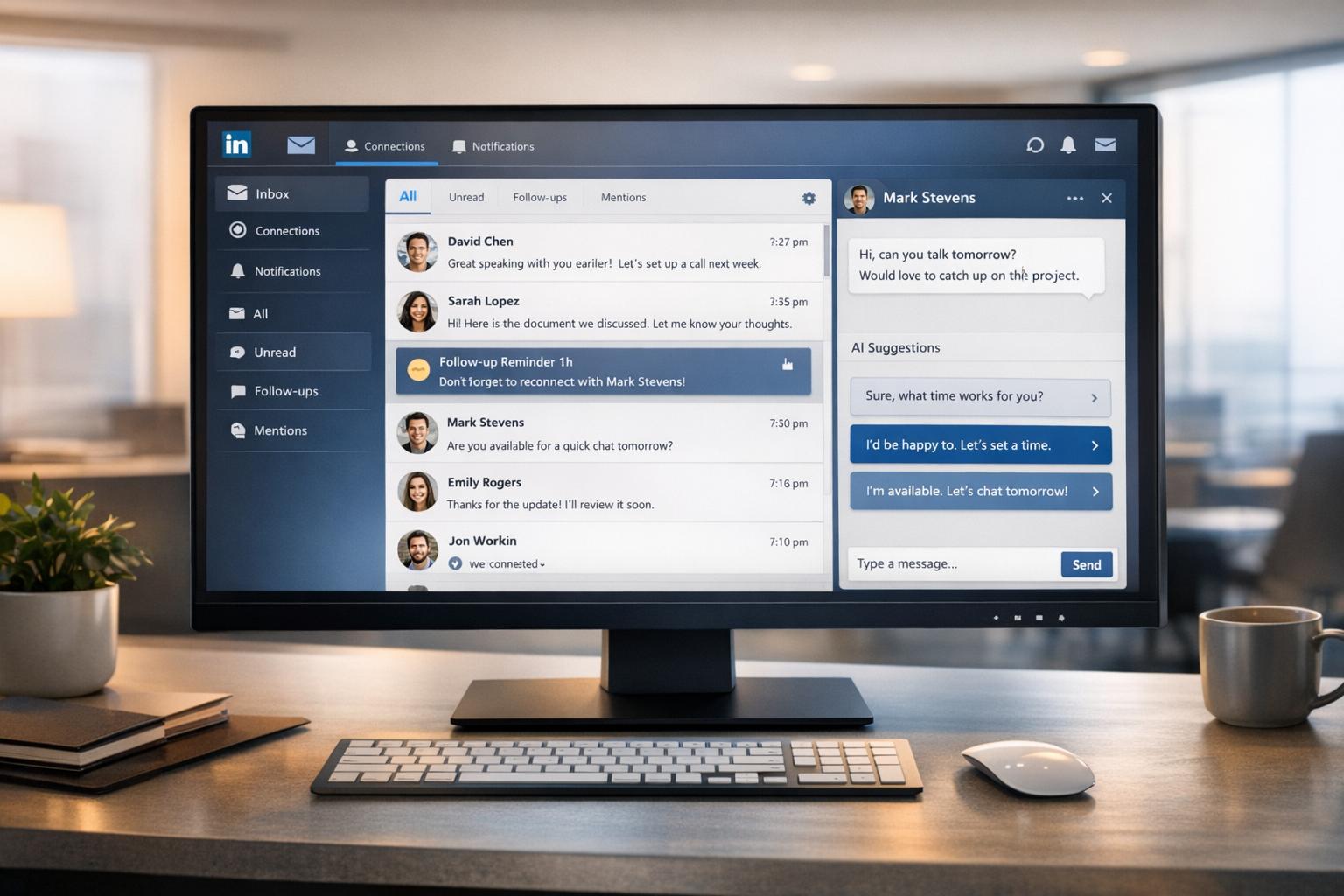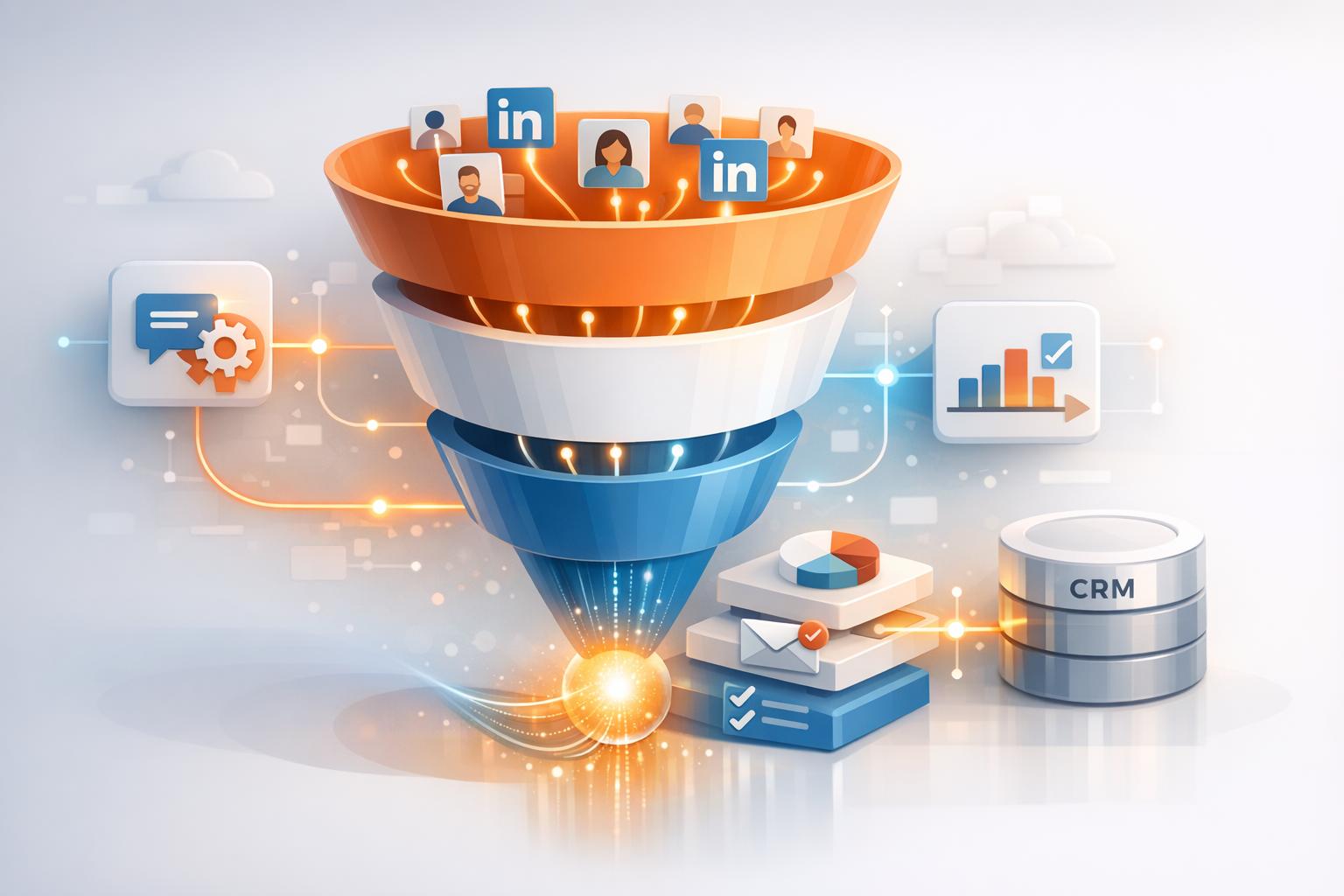
Predictive lead scoring is reshaping how businesses prioritize prospects by using AI to analyze data like website activity, email engagement, and CRM interactions. Tools like HubSpot, Salesforce Einstein, and Zoho CRM Zia AI help sales teams identify high-converting leads, improve forecasting, and automate workflows. Key benefits include up to 30% higher conversion rates and 20% increased productivity.
Here’s a quick breakdown of the tools covered:
- SalesMind AI: Focused on LinkedIn B2B lead generation with automated outreach and real-time scoring.
- Salesforce Einstein: Advanced machine learning for large-scale data analysis with seamless Salesforce integration.
- HubSpot Predictive Scoring: User-friendly, dynamic lead scoring built into its CRM for marketing and sales alignment.
- Zoho CRM’s Zia AI: Affordable AI-driven scoring with workflow automation for small to mid-sized businesses.
- Microsoft Dynamics 365: Deep insights for data-rich enterprises with strong Microsoft ecosystem integration.
Each tool has its strengths and weaknesses, so choosing the right one depends on your business size, goals, and budget.
Setting Up Predictive Lead Scoring Using Machine Learning
1. SalesMind AI

SalesMind AI is designed to make LinkedIn-based B2B prospecting smarter and more efficient. It uses predictive lead scoring powered by AI to help businesses identify and prioritize the leads most likely to convert. Let’s break down how its data analysis, AI technology, integration, and automation work together to streamline LinkedIn sales processes.
Data Sources Analyzed
To create detailed lead profiles, SalesMind AI dives deep into LinkedIn data. It examines profile details like job titles, industries, and company sizes, as well as engagement metrics such as open rates, response rates, and interaction history. It also factors in signals like profile completeness and activity levels. This thorough analysis enables the platform to develop scoring models tailored to social selling.
AI Capabilities
The platform’s machine learning algorithms are designed to evolve. Instead of relying on rigid, rule-based systems that assign fixed scores for specific actions, SalesMind AI identifies complex patterns that indicate the likelihood of conversion. By continuously learning from historical engagement and conversion data, the system ensures that lead scores stay relevant - even as market trends and buyer behaviors shift.
Integration Features
SalesMind AI integrates directly with LinkedIn, allowing users to manage prospecting workflows without switching between platforms. One standout feature is its AI-powered unified inbox, which consolidates all LinkedIn communications. This makes it easier to organize outreach efforts and manage interactions efficiently.
Workflow Automation
Automation is at the heart of SalesMind AI. The platform uses AI to craft personalized outreach messages, focusing on high-priority leads with tailored follow-ups while assigning lighter-touch campaigns to lower-priority prospects. As interactions progress, lead scores are updated in real time, ensuring sales teams can concentrate on the most promising opportunities.
"SalesMind AI gives us a new channel in LinkedIn sales. As a marketing agency, we will be able to use SalesMind to get in touch with precise clients on LinkedIn and create as many conversations as we can. It cuts down the working time and helps us close the deals. Best B2B sales product I have ever used."
- Si Wen, Regional Business Manager, ADI Resourcing
2. Salesforce Einstein Lead Scoring
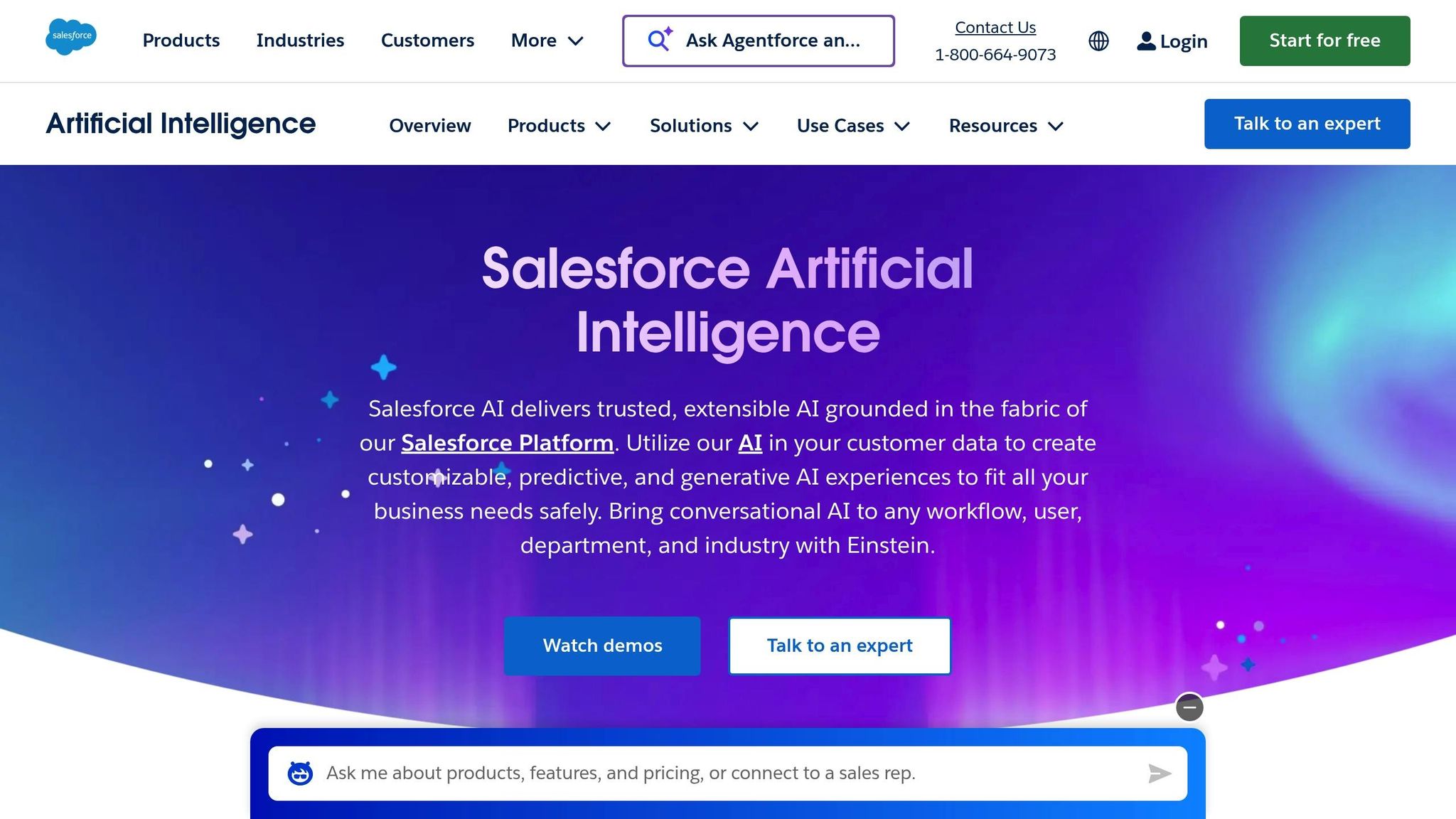
Salesforce Einstein Lead Scoring leverages machine learning to dig into historical sales data and predict which leads are most likely to convert. By doing this, sales teams can zero in on the best opportunities without slogging through endless spreadsheets. Unlike manual methods, Einstein keeps evolving, learning from live data to fine-tune its lead prioritization process.
Data Sources Analyzed
Einstein pulls data from a variety of sources to create detailed lead profiles. It looks at website activity, email engagement, and content interaction - all tracked through Salesforce's tools. It also factors in firmographic details like company size, industry trends, and growth potential. On top of that, CRM data - such as engagement timelines, pipeline movement, and response habits - is used to assess how ready a lead is to buy. This multi-layered approach uncovers patterns that might otherwise go unnoticed. For instance, Einstein might identify that leads from SaaS companies with 50–200 employees who follow a specific path - checking out product features, reading case studies, and then visiting the pricing page - are 78% more likely to convert than the average lead [1].
AI Capabilities
Traditional lead scoring often relies on static, manual methods, but Einstein takes a more dynamic approach. It continuously learns from customer behavior, comparing current leads to past customers to uncover new patterns [9]. As it processes more data, it adapts to changing market trends. For example, Einstein might find that leads who visit the pricing page twice in a week are 40% more likely to convert or that decision-makers from mid-sized tech companies often sign up after attending a webinar [9]. This ongoing refinement not only simplifies lead scoring but also eliminates the need for constant manual updates. Companies using Einstein Lead Scoring have seen up to a 30% boost in lead conversion rates and a 20% cut in time spent on unqualified leads. Plus, the model analyzes dozens - or even hundreds - of variables for each lead, far surpassing the capabilities of manual scoring methods [7].
Integration Features
Einstein Lead Scoring seamlessly integrates with the Salesforce ecosystem, working effortlessly with tools like Sales Cloud, Service Cloud, and Marketing Cloud [10]. Lead scores are automatically populated in the Salesforce CRM, drawing from a complete history of customer interactions - spanning sales activities, support tickets, and marketing campaigns [2]. Additionally, it supports third-party integrations through Salesforce's API and AppExchange, enabling teams to include external data like social media activity, intent signals, or industry-specific insights in their scoring models [9].
Workflow Automation
Einstein takes the hassle out of lead prioritization by automating the scoring process directly within your CRM [2]. It assigns scores and triggers actions based on thresholds, ensuring high-priority leads are routed to the right team members and follow-ups are initiated automatically [2]. Scores are displayed alongside key factors - such as repeated visits to the pricing page or high email engagement - allowing teams to make informed decisions while streamlining workflows [4]. This automation not only saves time but also ensures that no promising lead slips through the cracks.
3. HubSpot Predictive Lead Scoring

HubSpot takes a forward-thinking approach to lead prioritization by using real-time data and machine learning, reflecting the growing trend of AI-powered CRM tools. HubSpot Predictive Lead Scoring analyzes thousands of data points, refining its scoring criteria as customer behaviors evolve. Unlike older, rule-based systems that assign static points for specific actions (like opening an email or filling out a form), HubSpot’s AI-driven model adapts dynamically, learning from new data and emerging patterns [1][5].
Data Sources Analyzed
HubSpot’s predictive scoring system creates detailed lead profiles by pulling from four main data categories:
- Analytics data: Tracks website visits, email interactions, and content engagement to uncover user intent.
- Firmographic data: Includes company details, industry trends, and growth signals to identify businesses that align with your offerings.
- Relationship data: Logs past interactions with sales teams, customer support, and partners to assess the depth of engagement.
- CRM data: Analyzes timelines, pipeline movement, and response behaviors to gauge sales readiness [1].
AI Capabilities
Using this wealth of data, HubSpot’s AI continuously improves its scoring process. It identifies complex behavioral patterns across numerous variables and touchpoints. As new data rolls in, the system’s machine learning algorithms refine the scoring criteria, ensuring more accurate prioritization over time [1][5].
Integration Features
HubSpot Predictive Lead Scoring is seamlessly built into the HubSpot CRM, streamlining workflows for sales and marketing teams. Lead scores are automatically displayed alongside contact records, and the system supports integration with external tools via APIs and third-party connectors [11][5].
Workflow Automation
HubSpot transforms lead scores into actionable steps by automating key processes. High-scoring leads are assigned to specific sales reps, enrolled in email campaigns, or added to follow-up task lists. Customizable thresholds ensure timely, personalized actions for promising leads. This automation is particularly useful for startups and small- to medium-sized businesses, helping them align sales and marketing efforts around data-driven priorities [11][3]. By focusing on streamlined automation, HubSpot sets itself apart in the predictive scoring space, paving the way for broader comparisons.
sbb-itb-817c6a5
4. Zoho CRM's Zia AI
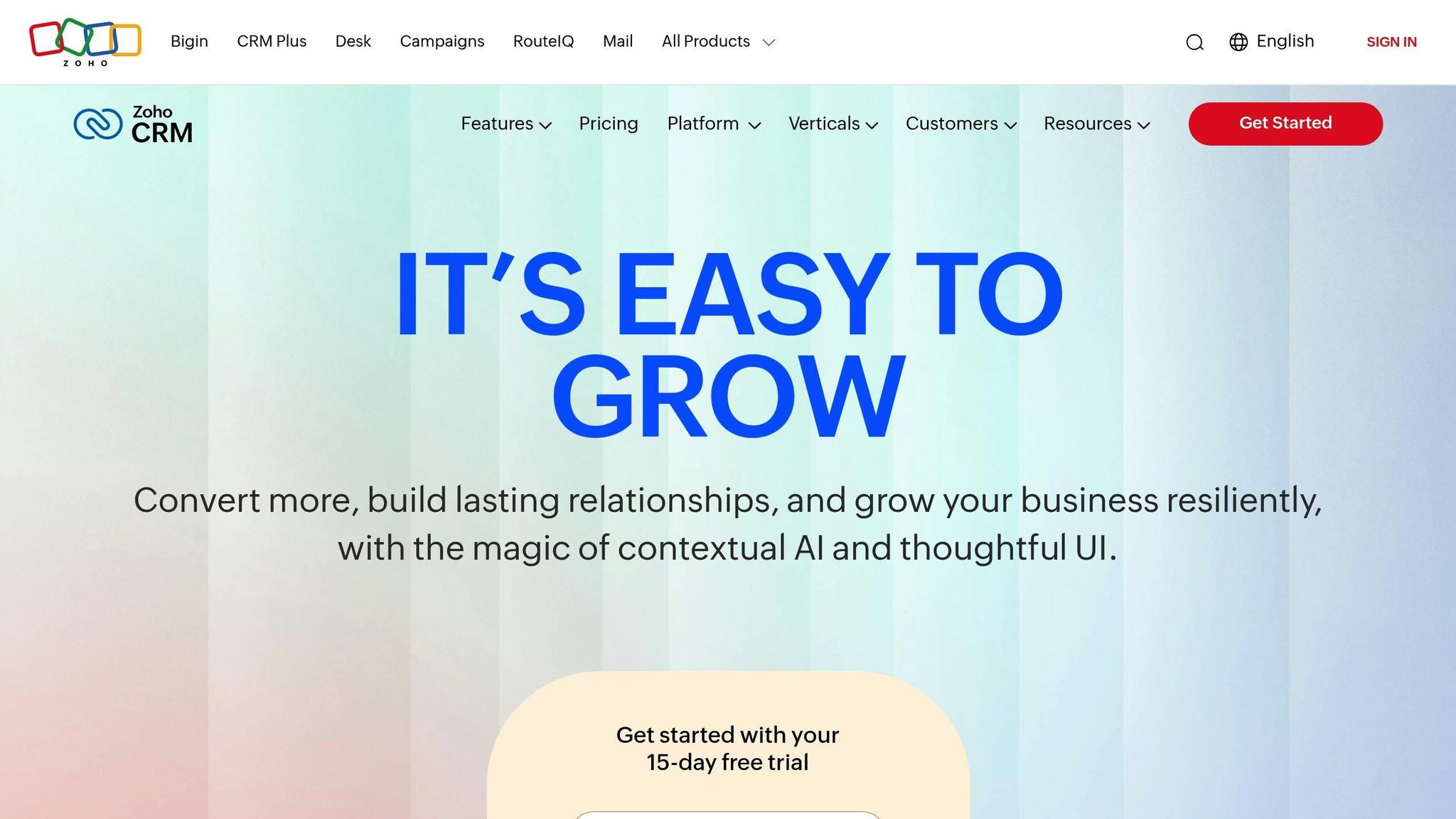
Zoho CRM's Zia AI transforms predictive lead scoring by combining multiple AI tools into a single, integrated system. Instead of relying on standalone features, Zia creates a well-rounded view of lead potential by analyzing over 50 data points for each lead [2].
Data Sources Analyzed
Zia AI builds detailed lead profiles by pulling data from several sources, including CRM history, email activity, website behavior, and social media interactions. It tracks CRM activity from the first interaction to the final deal, monitors email metrics like open rates, click-throughs, and response patterns, and examines how prospects navigate your website. Social media engagement and demographic details - such as job titles, company size, and industry - add depth, capturing both visible actions and subtle signals [1][2]. This mix of data gives Zia a solid foundation to deliver precise insights.
AI Capabilities
Zia uses machine learning to uncover patterns and detect anomalies. For example, its sentiment analysis evaluates the tone of emails and social media messages, helping sales teams adapt their communication style. It also identifies the best times to reach out to leads based on past engagement trends, boosting the chances of a successful connection. Over time, Zia's models become more accurate, refining lead scores continuously. Businesses using Zia's predictive scoring have reported up to a 30% boost in lead conversion rates and a 25% shorter sales cycle [2].
Integration Features
Zia AI works seamlessly within the Zoho ecosystem, connecting with tools like Zoho Campaigns for marketing automation and Zoho Desk for customer support insights. This integration ensures lead scores update automatically as new data flows in from various channels. Zia also supports third-party apps via APIs and marketplace connectors, making it versatile for different workflows. For US-based users, Zia complies with American English conventions, US dollar formatting, and CCPA data privacy standards.
Workflow Automation
Zia streamlines processes with smart automation. High-scoring leads are assigned to sales reps based on criteria like territory or expertise, while follow-up reminders and task assignments keep teams on track. For instance, a B2B SaaS company found that webinar attendees and email-engaged leads were 60% more likely to convert. With this insight, Zia prioritized these leads, resulting in a 25% rise in sales-qualified leads and a 15% shorter sales cycle [1][2]. Additionally, Zia enrolls promising leads in targeted nurture campaigns, ensuring no valuable prospect slips through the cracks while allowing sales teams to focus on direct engagement.
5. Microsoft Dynamics 365 Sales Predictive Lead Scoring

Microsoft Dynamics 365 Sales is a powerful tool for predictive lead scoring, seamlessly integrated within the broader Microsoft ecosystem. Designed for teams with substantial historical data, this platform requires at least 40 qualified and 40 disqualified leads over a period of three months to two years, making it a solid choice for organizations with robust data histories [4].
Data Sources Analyzed
Dynamics 365 delves into a variety of data sources, including historical leads, CRM interactions, and demographic details like company size and industry. It also evaluates behavioral data, such as website visits and email engagement. By combining these layers of information, the system identifies both straightforward actions and subtle signals that indicate a lead's likelihood to convert [4].
AI Capabilities
The platform’s AI leverages machine learning to detect patterns in lead conversion and assigns numerical scores to prioritize leads effectively. For instance, a lead with a score of 80 is more likely to convert compared to one scoring 50. The system not only provides these scores but also highlights the key factors influencing them, offering transparency. Plus, it continuously refines its models as new data becomes available [4].
Integration Features
One of the standout benefits of Dynamics 365 is its deep integration within the Microsoft ecosystem. It connects effortlessly with tools like Power BI for advanced analytics, Microsoft Teams for team collaboration, and Power Automate to streamline workflows. Additionally, APIs allow businesses to link external marketing automation and data tools. For U.S.-based companies, the platform aligns with American English standards, uses U.S. dollar formatting, and ensures compliance with relevant data privacy regulations [4].
Workflow Automation and Pricing
Dynamics 365 streamlines lead management by automating key tasks. When a lead's score crosses a set threshold, the system can notify the assigned sales rep, schedule follow-ups, and update the CRM status - preventing high-potential leads from slipping through the cracks. Pricing starts at $65 per user per month for the Professional plan, while the Enterprise plan, which includes predictive scoring, is available at $95 per user per month [4].
Advantages and Disadvantages
Let’s break down the key strengths and limitations of the AI-powered predictive scoring tools discussed earlier, helping you make a more informed decision for your business.
Each tool brings its own set of benefits and drawbacks, making the choice highly dependent on your specific needs and goals. Here's what stands out:
SalesMind AI is a standout for LinkedIn-focused lead generation, boasting impressive metrics like a 40% acceptance rate, a 45% reply rate, and a pipeline value of $100,000 per month. Its AI-powered unified inbox and seamless LinkedIn integration make it a strong choice for B2B social selling. However, its heavy focus on LinkedIn may leave users wanting more comprehensive CRM capabilities.
"Amazing tool that allowed me to save so much time on my LinkedIn outreach. But that's not all - by automating all conversations and personalizing them with direct insights extracted from my prospect profiles, it gives accurate and high-quality outputs that helped me get more prospect meetings and thus close more deals! It's definitely a game changer, thanks for this great tool!"
– Sébastien D., Freelance, Freelance Insider [8]
Salesforce Einstein offers robust integration within the Salesforce ecosystem, providing transparent scoring factors and customization options. It excels in handling large-scale data analysis and connects seamlessly with third-party applications, making it ideal for enterprise-level operations. The downside? Its pricing starts at $150 per user per month, and the complexity of setup can be daunting for smaller teams without technical expertise [6].
HubSpot's Predictive Lead Scoring shines with its intuitive interface and strong integration with marketing automation tools. One SaaS company reported a 78% higher conversion rate for leads from mid-sized tech firms that interacted with product features, case studies, and pricing pages. This highlights the tool’s ability to identify valuable patterns. However, it’s worth noting that access to predictive scoring requires higher-tier plans, starting at $800 per month, which might be steep for smaller businesses [1][6].
Zoho CRM's Zia AI is an affordable option at $40 per user per month, offering workflow automation and AI-driven insights. This makes it appealing for growing businesses. However, it lacks some of the advanced features found in enterprise-level tools and may require technical expertise to set up properly [6].
Microsoft Dynamics 365 Sales delivers deep insights and integrates effortlessly with Microsoft’s suite of business tools. That said, it has a high data threshold, requiring at least 40 qualified and 40 disqualified leads over periods ranging from three months to two years. This can be a hurdle for newer businesses or those with limited data [4].
| Tool | Key Advantages | Key Disadvantages | Pricing (USD) |
|---|---|---|---|
| SalesMind AI | LinkedIn automation, 40% acceptance rate, unified inbox | Limited to LinkedIn, custom pricing | Custom quote |
| Salesforce Einstein | Deep CRM integration, scalable, customizable | High cost, complex setup | $150/user/month |
| HubSpot Predictive Lead Scoring | User-friendly, excellent marketing integration | Expensive higher-tier plans | $800+/month |
| Zoho CRM Zia AI | Affordable, workflow automation | Fewer enterprise-grade features | $40/user/month |
| Microsoft Dynamics 365 | Microsoft integration, detailed insights | High data requirements | $95/user/month |
Across all platforms, common challenges include data silos, inconsistent data quality, and a lack of team understanding when it comes to interpreting scores [2][9]. Poor-quality or insufficient data can hinder predictive accuracy, regardless of the tool.
To get the most out of these tools, experts recommend a few best practices: routinely auditing data quality, tailoring scoring models to align with business objectives, and involving sales teams in the feedback process to ensure the scores remain actionable [2][9].
These insights pave the way for a deeper analysis of broader market trends in the final section.
Final Thoughts
Picking the right AI-powered predictive scoring tool isn’t just about ticking off a features list - it’s about aligning the tool with your business goals and sales strategy. Each platform has its own strengths, and understanding how these align with your needs can make a huge difference in your results.
For B2B businesses prioritizing LinkedIn outreach, SalesMind AI stands out. With its AI-driven unified inbox and automated follow-ups, it achieves an impressive 40% acceptance rate and helps generate a $100,000/month pipeline [8].
Small to mid-sized businesses often find value in HubSpot's predictive lead scoring, which identifies high-converting behaviors like a 78% higher conversion rate when leads engage with pricing pages or downloads [1]. However, its premium pricing can be a hurdle for those with tighter budgets.
For enterprises, Salesforce Einstein and Microsoft Dynamics 365 shine with their advanced customization and analytics. Salesforce Einstein offers transparent scoring and integrates seamlessly with third-party tools, while Dynamics 365 provides detailed insights and works smoothly with Microsoft’s ecosystem.
If budget is a primary concern, Zoho CRM’s Zia AI offers a more affordable option, though it lacks the depth of features found in higher-end tools.
These comparisons highlight the importance of matching the tool to your sales process. A mismatch can lead to irrelevant scores, wasted time, and missed opportunities. For LinkedIn automation, specialized tools like SalesMind AI are ideal, while businesses with complex, multi-touch sales cycles need platforms offering advanced analytics [10][2].
Lastly, the quality of your data is the backbone of effective predictive scoring. Regularly auditing your data, maintaining clean datasets, and ensuring your systems are well-integrated allow AI insights to work in harmony with human expertise. The best implementations create feedback loops that refine scoring over time, ensuring continuous improvement [2][9].
FAQs
How can AI-powered predictive lead scoring boost sales team efficiency and improve conversion rates?
AI-powered predictive lead scoring allows sales teams to zero in on the leads most likely to pan out by analyzing customer behavior, engagement trends, and historical data. By focusing on these high-potential opportunities, teams can use their time and resources more efficiently, boosting productivity across the board.
On top of that, predictive scoring helps improve conversion rates by pinpointing leads with the greatest chance of converting. This insight enables more personalized outreach and follow-ups that resonate with potential customers. With this data-driven strategy, the sales process becomes less about guesswork and more about precision, ultimately enhancing team performance.
How does AI-powered predictive lead scoring enhance CRM processes?
AI-driven predictive lead scoring is reshaping how businesses handle CRM processes. By analyzing massive datasets, it uncovers patterns and predicts outcomes, enabling companies to prioritize leads more efficiently, make more precise sales forecasts, and spot customers who may be at risk of leaving - all before it’s too late.
Platforms like SalesMind AI elevate this approach by automating tasks like lead qualification and follow-ups. This frees up sales teams to concentrate on what they do best: building strong, genuine relationships with high-potential prospects. With these AI-powered insights, businesses can fine-tune their sales strategies and drive noticeable growth.
How can businesses improve the accuracy and reliability of predictive lead scoring in their CRM systems?
To get the most out of predictive lead scoring, businesses should zero in on these three important areas:
- Data Quality: Start with clean, current, and relevant data. If your data is outdated or incomplete, your scoring model won't be reliable.
- Model Evaluation: Keep testing and fine-tuning your predictive model. Use metrics like precision, recall, and accuracy to measure performance and spot areas that need improvement.
- AI Tools: Invest in advanced tools like SalesMind AI. These tools use artificial intelligence to spot patterns, prioritize leads, and enhance sales efforts.
When you combine reliable data, consistent evaluation, and cutting-edge technology, predictive lead scoring becomes a game-changer for your CRM system.


.avif)
